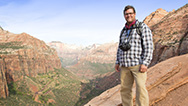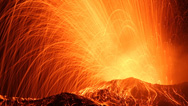The Volcano Under Yellowstone
- By Ari Daniel
- Posted 11.26.15
- NOVA
North America has been sliding across a fiery mass of magma for millions of years. It’s triggered some of the most violent eruptions and most devastating extinctions the continent has ever experienced. And now it’s parked beneath Yellowstone National Park where it’s just a matter of time before it detonates again.
Transcript
Kirk Johnson: Yellowstone National Park contains one of our country’s favorite landmarks. But it’s actually a warning signal… going off every hour.
Now we’re going. Wow, that’s roaring, man, I love that.
This is Old Faithful.
That’s what they call a geyser. What we’re seeing is super heated water and steam blowing out of the ground. It’s been doing this for 100 years plus and it’s a really reliable tourist attraction because the thing goes off like clockwork.
It’s one of the most powerful geysers in the world—capable of shooting 8500 gallons of super heated water as high as an 18-story building.
It’s a constant reminder that lurking beneath the surface is a ticking time bomb.
You see, although it may not seem like it, I’m actually standing on top of a volcano.
And Park Geologist Hank Heasler wants to show me what it looks like underground.
Henry Heasler: And this is a…
Johnson: Oh, look at that, you can see the thing.
Heasler: …three dimensional model.
Johnson: This is a magma chamber—a mass of semi molten rock reaching almost 1500 degrees Fahrenheit—it’s the powerhouse of a volcano.
Heasler: That’s, one of the larger chambers that had been mapped in the world.
Johnson: Wow, but can we agree that we’d like to keep it down there?
Heasler: I don’t think we have a choice. It's going to do what it wants to do.
Johnson: Together with a second recently discovered magma chamber, there’s enough partially molten rock under Yellowstone to fill the Grand Canyon 13 times over.
And scientists believe below them, lies a mantle plume. A column channeling heat from the Earth’s core, melting the rocks above, and creating the massive magma chambers under Yellowstone.
If this super volcano ever erupted, we’d be in trouble...
There’s a place in Nebraska where you can see just how bad things could get. Inside this plain steel barn is a 12-million-year-old animal Pompeii. Here, the fossilized skeletons of 200 animals—mostly rhinos and horses—lie frozen in the exact position in which they died.
The man who discovered this site is paleontologist Mike Voorhies.
Michael Voorhies: We’ve found the remains of more than 50 species of animals. 12 million years ago, our wildlife was similar in richness to the east African savannahs of today.
Johnson: The grey dust that entombs these animals is what killed them: ash from a massive volcanic eruption.
Voorhies: There was so much of it that the air was polluted and animals had to breathe dust for weeks and weeks and weeks and they ended up dying by the thousands.
Johnson: And the mantle plume that we think made this super volcano is still around.
Our continent has been sliding over this hot spot, which has triggered numerous eruptions. And now it sits beneath Yellowstone.
So the plume under our most famous national park is a repeat offender—that will strike again.
Voorhies: It’s hard to imagine that much volcanic ash, and yet we know that this kind of event has happened before, and almost certainly it will happen again.
Johnson: A super eruption in Yellowstone would be a really bad day for North America.
As a geologist I’d love to see this thing erupt… but as a North American not so much!
It would rank as the most violent event since humans first set foot on the continent.
Credits
PRODUCTION CREDITS
- Writer and Editor
- Ari Daniel
- Director
- Gwyn Williams
- Producer
- Mat Stimpson
- Director of Photography
- Piers Leigh
- Narration
- Kirk Johnson
- Research Assistance
- Ceri Riley
- Original Footage
- © WGBH Educational Foundation 2015
MEDIA CREDITS
- Motion Graphics
- Fluid Pictures
- Music
- APM
IMAGE
- (main image: Yellowstone geyser)
- © WGBH Educational Foundation 2015
Related Links
-

Making North America
Host Kirk Johnson explores how the continent was shaped—and how it shaped us.
-

How Panama Changed the World
Two scientists scan islands off Panama for clues to determine how the country was formed.
-

Towers of Chalk in Kansas
Amidst the flat plains of Kansas are the gorgeous remains of an ancient inland sea.
-

Deadliest Volcanoes
From Japan's Mt. Fuji to Yellowstone's buried supervolcano, how can we best prepare for the most lethal eruptions?

